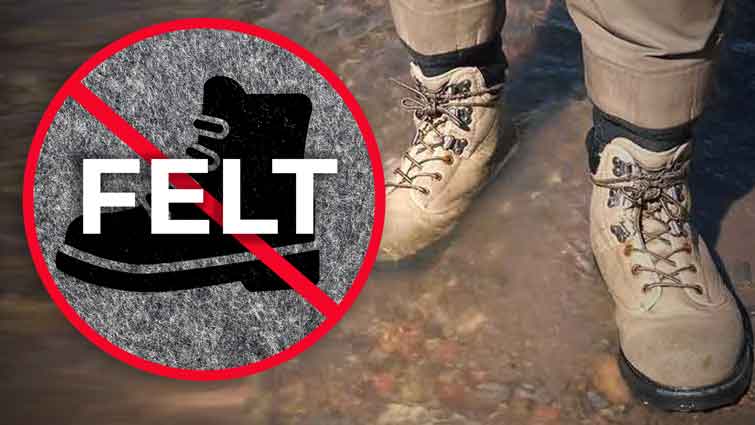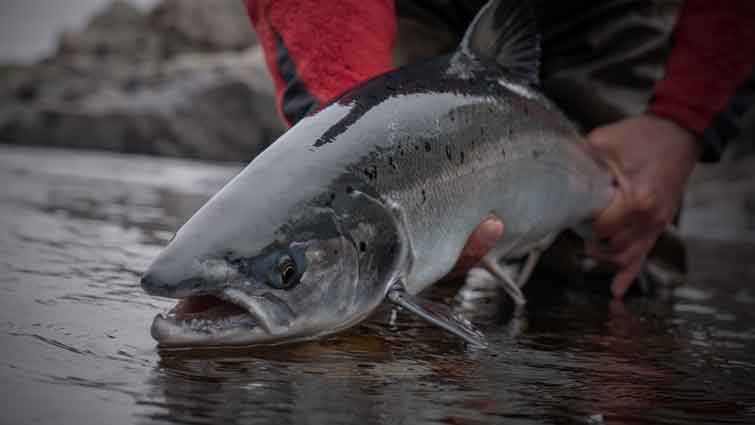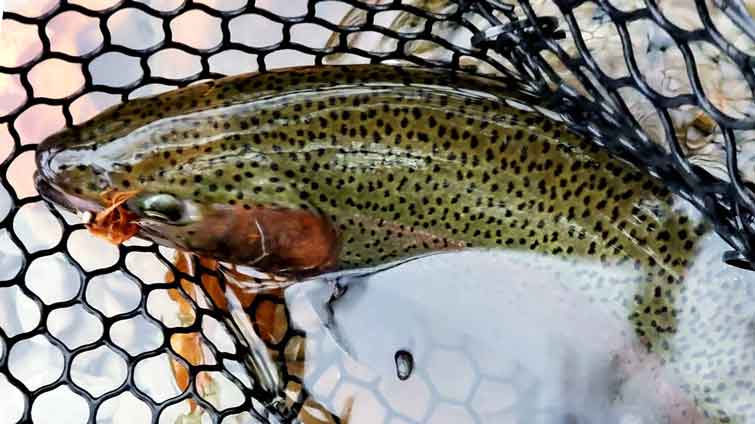Fly fishing is an American pastime that is well-loved. It's also a leisure sport that requires a great deal of equipment, especially since most of your time is spent wading in rivers and lakes. One of the essential pieces of equipment that keeps you upright, balanced, and moving with ease is wading boots. A necessary element of a good wading boot is the sole, whether rubber, felt, or cleated. Now, while every angler will have their preference, you may not get the option of felt wading boots, depending on where you live.
Maryland, Alaska, Missouri, Nebraska, Rhode Island, and South Dakota have all banned the use of felt wading boots in their waters. It comes to a total of six states and one national park, Yellowstone, which is in Wyoming.

It may come as a surprise that several states would ban a simple piece of outerwear, but each state has its reason for why they feel the need to disqualify felt wading boots from among the pack. Those reasons may be in the interest of both the fisherman and the delicate ecosystem they disrupt when participating in their beloved hobby.
States That Have Banned Felt Wading Boots
While you can find a body of water in any state where you can fish, not all your equipment and gear are welcomed in that state. State regulations are for protecting its citizens and the ecosystem of its precious natural areas. That protection ensures that those natural areas can continue to be enjoyed for generations to come.
Currently, six states have banned felt wading boots, but many other states are also considering banning the shoes as well. Each state has had its unique factors that brought them to the decision to ban felt soles, but all were in an effort to protect their waters.

Maryland
Maryland passed the ban on felt sole wading boots back in 2011. The primary concern for the state was the infestation of Didymo, also known as "Rock Snot." This algae has recently been introduced to North America but has the potential to wreak havoc on the fish population itself, as well as the fish food supply. The rate at which the invasive species grows, covering rivers and streams with a yellow-brown layer of slime, can also make fishing quite tricky, nay impossible.
Changes in the biology of the stream have been scientifically verified. Therefore, Maryland imposes a prepayable fine for felt-soled wader boots in the amount of $125. The maximum penalty for first-time violators is $1,000, with a $2,000 penalty for a second violation.

Alaska
In addition to Didymo, Alaska has also contended with the New Zealand mudsnail and myxobolus cerebralis. To prevent the continued spread of these invasive species, they banned felt sole wading boots in 2012.
The New Zealand mudsnail is asexual and able to reproduce without a mate. Therefore, the snail spread could get to half-million per square yard. The result would be total degradation of streams with the destruction of the food supply for fish.
Myxobolus cerebralis is a parasite discovered in Southcentral waters as far back as 2007. The pathogen was found to implant itself into felt soles more easily than other wading equipment. Myxobolus Cerebralis affects salmon and trout, causing neurological damage and deformities in the skeleton. The result is an off-kilter swimming pattern that makes them more vulnerable to predators and makes it challenging to feed.
While there is no specified fine for violators, Alaska Fish and Wildlife will issue citations for non-compliance, which may result in a financial penalty.

Missouri
The ban in Missouri is not just on felt but any porous soled wader of any fibrous material, woven or matted. The restriction is due to the algae Didymo, which has proven highly susceptible to spreading via porous material, being on the list for three states thus far.
Missouri's ban also took place in 2012. The state has taken precautions to slow the spread of the invasive species by installing wader wash stations at five major cold-water trout hatcheries. Despite this effort, they still require anglers to replace their porous soled waders or apply marine rubber cement to the soles of their boots.
What makes Didymo a more significant issue in the waters of Missouri is the higher pH levels created by limestone. Other states can stave off infestation of this algae because lower acidity or pH levels naturally keep the plant in check.

Nebraska
Nebraska's ban on felt sole wader boots was adopted in 2013. The spread of invasive species caused the state to enact this measure, among other regulations on boats and trailers. The concern to Nebraska waters is zebra and quagga mussels.
While it might seem unlikely that a wader could effectively transfer a mussel from one body to another, both species are capable of surviving out of the water for up to two weeks. Zebra mussels, in particular, are virtually naked to the human eye during the larval stage, spreading through droplets of water. In cold enough temperatures, the larva can live in drops of water for 27 days.
Nebraska Game Parks also notes that aquatic plants can spread through felt soles in small fragments.

Rhode Island
Rhode Island's ban on felt sole wader boots was enacted in 2012 and immediately amended. Initially, the ban was to all state waters, including freshwater, saltwater, and tidal. The purpose was to stave off the growth of Didymo that had been affecting Rhode Island and surrounding states. However, since the algae do not affect all waters, the state amended the ban to restrict the felt soles in freshwater.
The intention behind the commencing ban was to make it easier to enforce. However, there was a backlash from surf casters who felt they were not taken into consideration in the drafting of the ban since they rely heavily on the felt-soled waders to keep them safe on the coast.

South Dakota
South Dakota was one of the most recent states to ban felt sole waders in 2013. The purpose of the ban was to prevent the transmission of AIS plants, including Didymo and AIS invertebrae, including the zebra mussel, the New Zealand mudsnail, and a new species to the list, the spiny water flea.
Spiny water fleas are microscopic zooplankton that pose a threat to the native zooplankton of the South Dakota waters. They are also a nuisance species often found in large clumps on fishing lines and other equipment, making it difficult for anglers to enjoy their hobby. Additionally, they do not provide a good food source for fish since their long spines and tails make them challenging to eat.
What makes spiny water fleas even more threatening to waters is that they produce resilient eggs that are impervious to freezing or drying, which are standard practices to "prevent" the spread of invasive species with felt sole wading boots.

Honorable Mentions
A few states have considered a ban on felt soles or had one in the past, though they have lifted the restriction. Oregon considered a ban with bill LC 1284 back in 2012 but was unsuccessful in passing the bill. In 2010, the New York City Department of Environmental Protection considered a ban in the lower Hudson Valley and specific trout streams of the Catskills, which affects their water supply.
Idaho tried banning felt sole waders in 2011, but a bill did not pass. Vermont did have a ban in place in 2010 but lifted it five years later. The lift on the ban was due to additional research conducted over the five-year period that proved that Didymo, the reason for the ban, was native to Vermont.

Frequently Asked Questions
Why Are Felt Wading Boots Banned?
Felt is one of three sole types for wading boots. Anglers gravitate toward felt soles because they offer more traction, especially in waters that tend to be more gravelly or sandy. They reduce the risk of slipping much more than their counterpart, rubber soles.
Felt wading boots are banned from six states because they are more likely to pick up and house invasive species, bacteria, parasites, and organisms. Once they are in the felt soles, they can be transferred to other bodies of water, disrupting the ecosystem and possibly causing a dramatic decline in native species.
There are alternatives to felt sole wading boots that can prove to be just as effective with slippage in certain precarious waters. Rubber soles are growing more popular, and some come with a cleated variation that can assist in staying upright.

Can You Wear Felt Sole Wading Boots in Idaho?
Though some states have banned felt sole wading boots and other states are considering following suit, there are still 44 states that have not denied the shoes from their waters. The lack of restriction may be due to other states not suffering the same.
Yes, you can wear felt sole wading boots in Idaho. Idaho has not entirely banned the felt soles on wading boots, but there are some places that restrict them, like The Nature's Conservancy Silver Creek Preserve.
Are Felt Soles Legal in California?
California enjoys a lush and diverse ecological community and takes conservation efforts seriously. California enjoys over 100 creeks, tributaries, rivers, and 400 recreationally open lakes, not to mention that the entire West side of the state is a coastline for the Pacific Ocean.
Yes, there is currently no regulation that prohibits the use of felt soles in the state of California. However, it is strongly encouraged that all felt soles be adequately cleaned and sanitized when moving from one body of water to another independent body of water. While techniques on disinfecting may vary from person to person, freezing or the complete removal of moisture from the felt sole are minimal options.

Are Felt Wading Boots Legal in Pennsylvania?
Every state deals with a list of invasive species that affect the biodiversity of that state. When it comes to felt wading boots, the concerns lie in two invasive species, in particular, Didymo (algae) and New Zealand mud snails. Both invasive species pose a threat to the fish supply in Pennsylvania, including game fish like trout and bass.
Yes, felt wading boots are legal in Pennsylvania. However, many conservation groups and the Pennsylvania Fish & Boat Commission highly discourage anglers from using them despite their legal status. They may be responsible for the current rise of invasive species in Pennsylvania waters.

Can You Wear Felt Sole Wading Boots in Montana?
Montana is at the top of the list for the most outdoorsy states, tying only with Alaska at 81%. In the state, 30% is public lands managed by agencies like the National Park Service, U.S. Fish, and Wildlife Service, U.S. Forest Service, etc. Many residents and non-residents enjoy the natural beauty, and wildlife Montana has to offer.
Yes, you can wear felt sole wading boots in Montana. There is currently no ban on these shoes in the state of Montana. There was an attempt to place a ban on felt soles in 2011, but it was not passed. Yellowstone National Park does have a ban on felt sole wading boots, regardless of what state you enter the park.
Despite the controversial status of felt sole wading shoes and the havoc they have the potential to wreak on different ecosystems, there are ways to combat the possible spread of invasive species. In each state's resource discussing the ban on felt sole waders and species that threaten their waters, they also gave options to anglers who use the shoes. Anglers can exchange their shoes for free or at a low cost, and they can alter the soles of their existing shoes to make them appropriate.
In addition, each state offered a thorough cleaning process for felt sole waders that included both disinfecting and sanitizing to prevent contamination. Even if you live in a state that allows felt sole waders, these measures should be taken. Invasive species can become an issue anywhere, and many states without bans already have an ongoing battle with invasive species.






5 comments
Gary Swearer
AK banned felt quite a few years ago, I’ve switched to spikes and don’t miss the felt at all Korkers markets a spiked sandel that will strap on to most wading boots. my waders are boot footed and the Korkers fit w/ no problems. The also work great on icy drives and sidewalks (the best I’ve found.
AK banned felt quite a few years ago, I’ve switched to spikes and don’t miss the felt at all Korkers markets a spiked sandel that will strap on to most wading boots. my waders are boot footed and the Korkers fit w/ no problems. The also work great on icy drives and sidewalks (the best I’ve found.
Robert Hammond
I would think shoe laces, the inner liners of wading shoes, and insulated waders would transfer these organisms just as easily. So is this just a gimmick to make these conservationists look like they are geniuses
I would think shoe laces, the inner liners of wading shoes, and insulated waders would transfer these organisms just as easily. So is this just a gimmick to make these conservationists look like they are geniuses
Steve Merritt.
I’m elderly, 73, and if my state bans felt doled a I’m effectively banned from wade fishing. I hope it doesn’t.
Maybe someone can come up with a way to have disposable felt doles so that can be replaced if going to a new body of water.
May not be practical but it’s just thought.
I’m elderly, 73, and if my state bans felt doled a I’m effectively banned from wade fishing. I hope it doesn’t.
Maybe someone can come up with a way to have disposable felt doles so that can be replaced if going to a new body of water.
May not be practical but it’s just thought.
Pat Stevens
Why can’t we just disinfect our felt boots before we enter a stream with bleach or something that will kill these bugs and weeds?
Why can’t we just disinfect our felt boots before we enter a stream with bleach or something that will kill these bugs and weeds?
Chris Clarke
Do you have any recommended procedure for de-contaminating or disinfection felt soles on wading boots?
Also, Are any of these prohibitions made with the idea of preventing the spread of whirling diease in fish?
Do you have any recommended procedure for de-contaminating or disinfection felt soles on wading boots?
Also, Are any of these prohibitions made with the idea of preventing the spread of whirling diease in fish?